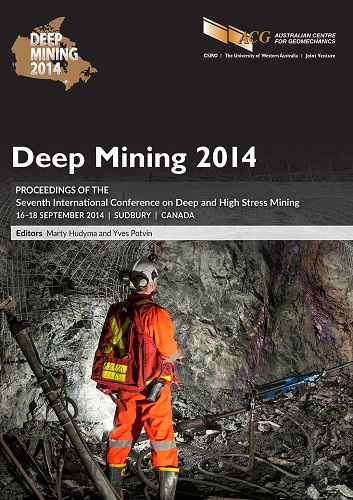Feasibility of Acti-Gel® as a cost-effective additive for underground mine hydraulic backfill applications

|
Authors: Tarr, K; Bedard, I; Malek, F; Kim, H |
DOI https://doi.org/10.36487/ACG_rep/1410_38_Tarr
Cite As:
Tarr, K, Bedard, I, Malek, F & Kim, H 2014, 'Feasibility of Acti-Gel® as a cost-effective additive for underground mine hydraulic backfill applications', in M Hudyma & Y Potvin (eds), Deep Mining 2014: Proceedings of the Seventh International Conference on Deep and High Stress Mining, Australian Centre for Geomechanics, Perth, pp. 545-557, https://doi.org/10.36487/ACG_rep/1410_38_Tarr
Abstract:
Backfill is an integral part of an underground mining operation. Its two main purposes are safety of the underground openings, and environmental remediation by use of mill tailings as a construction material underground. Backfill will play a vital role in the process of ore extraction in deep mining, as a solution to rock stability issues. Depending on the mining method used, backfill provides a working surface, stabilises stope and pillar walls, as well as the surrounding rock mass, and controls caving of stope backs. The economic feasibility of many mining techniques depends on the ability to place competent backfill in the underground voids to ensure safe working conditions. Portland cement is primarily used to solidify backfill, which represents a major cost in mining operations. In addition, the manufacturing of cement raises environmental considerations because it produces a considerable amount of CO2 emissions. Therefore the search for additives which allow for a reduction in the required cement content in backfill has been ongoing for decades. Acti-Gel® is a highly purified magnesium aluminosilicate that acts as a high performance anti-settling agent and rheology modifier used in a wide variety of water-based industrial applications. Previous studies have shown that as an additive in paste backfill, it results in improved strength and flow properties, such as friction loss and segregation. Since additives may perform differently in a hydraulic system with various backfill materials, it is recommended to conduct controlled laboratory testing on the additive with the materials and binder used at each specific mine site. This is done to determine the additive’s suitability for use in a given underground mine’s backfill operation, in order to ensure the integrity of the flow properties as well as the resulting backfill matrix. This paper presents the results of a study conducted at the CanmetMINING Sudbury Laboratory to investigate the feasibility of Acti-Gel®, as a cost-effective additive for underground hydraulic backfill applications. The materials and binder used in the study were from two of Vale’s Operations in the Sudbury Basin; Coleman Mine and Creighton Mine. The materials were first physically characterised, followed by the preparation of samples to determine optimal dosages of the additive for strength development required for Vale’s hydraulic fill compliance. In addition, specialised laboratory pilot studies to determine Acti-Gel®’s effect on flow properties were conducted. It was found that at a low dosage of 0.03 wt%, Acti-Gel® delivered enhanced performance in unconfined compressive strength tests as well as in the pilot-scale flow tests. A significant reduction in binder content could be realised with addition of Acti-Gel® at the Coleman and Creighton Mine operations. The economic benefits of such a binder reduction are also discussed in this paper.
References:
Ackim, M 2011, ‘Development of a suitable mine backfill material using mine waste for safe and economical ore production at Konkola Mine (Zambia)’, Master of Mineral Sciences Degree Dissertation, The University of Zambia, Lusaka.
Archibald, J, De Souza, E & Beauchamp, L 2009, ‘Compilation of industry practices for control of hazards associated with backfill in understand mines – part II underground transport and stope placement’, in M Diederichs & G Grasselli (eds), Proceedings of the 3rd CANUS Rock Mechanics Symposium: ROCKENG09, paper 4185.
ASTM International 2011, C702: Standard Practice for Reducing Field Samples of Aggregate to Testing Size, ASTM International, West Conshohocken.
Grice, T 1998, ‘Underground Mining with Backfill’, Proceedings of the 2nd Annual Summit – Mine Tailings Disposal Systems, Australian Institute of Mining and Metallurgy, Carlton, pp. 1-14.
Hartman, HL 1992, SME Mining Engineering Handbook, 2nd edn, Society for Mining, Metallurgy, and Exploration, Littleton.
Wang, X-M, Zhao, J-W, Xue, J-H & Yu, G-F 2011, ‘Features of pipe transportation of paste-like backfilling in deep mines’, Journal of Central South University of Technology, vol. 18, no. 5, pp. 1413-1417, viewed 1 August 2014, http:/www.researchgate.net
/publication/225357473.
© Copyright 2025, Australian Centre for Geomechanics (ACG), The University of Western Australia. All rights reserved.
View copyright/legal information
Please direct any queries or error reports to repository-acg@uwa.edu.au
View copyright/legal information
Please direct any queries or error reports to repository-acg@uwa.edu.au